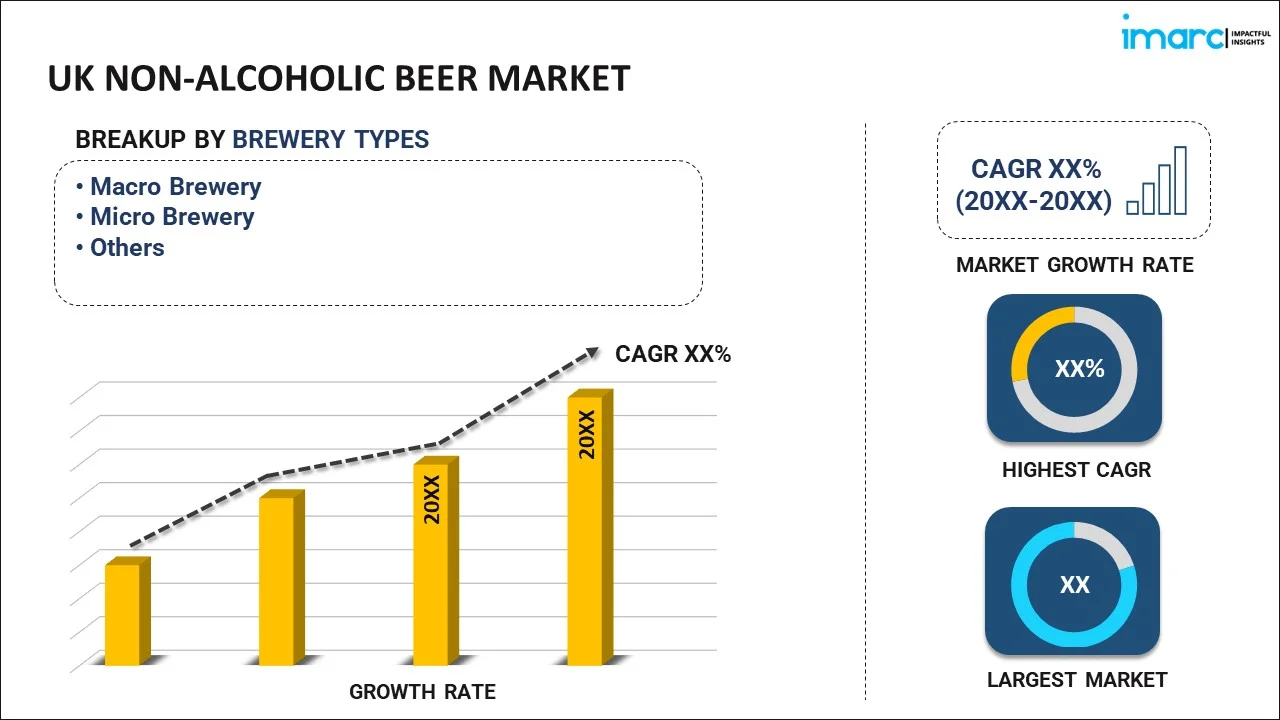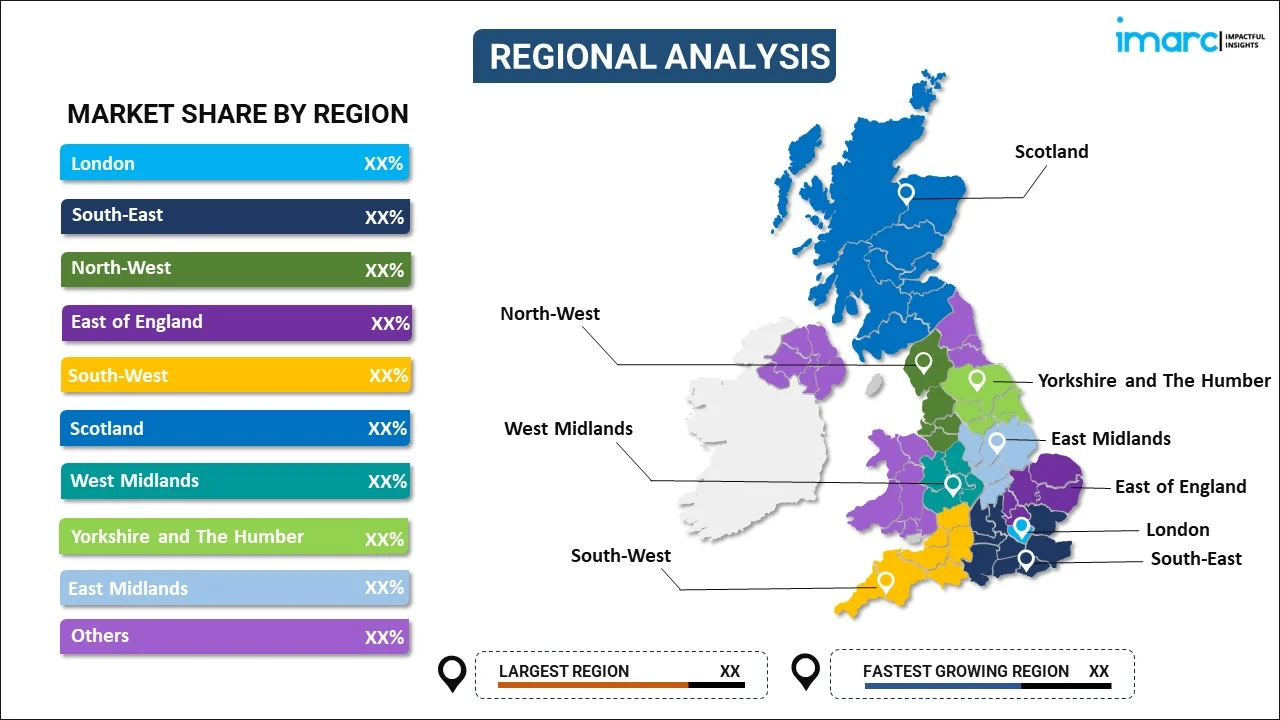
UK Non-Alcoholic Beer Market Report by Brewery Type (Macro Brewery, Micro Brewery, and Others), Technology (Restricted Fermentation, Dealcoholization, and Others), Flavour (Flavoured, Unflavoured), Packaging (Glass Bottles, Metal Cans, and Others), Distributional Channel (Direct Sales, Supermarkets and Hypermarkets, Convenience Stores, Specialty Stores, Online Retail, and Others), End User (Institutions, Direct Consumers), and Region 2025-2033
UK Non-Alcoholic Beer Market Overview:
The UK non-alcoholic beer market size reached USD 152.4 Million in 2024. Looking forward, IMARC Group expects the market to reach USD 216.9 Million by 2033, exhibiting a growth rate (CAGR) of 4% during 2025-2033. Rising health and wellness concerns among consumers, unique product developments in the market, widespread adoption of effective marketing strategies, growing awareness of non-alcoholic beer, and improved brewing processes represent some of the key factors driving the growth of the market.
|
Report Attribute
|
Key Statistics
|
|---|---|
|
Base Year
|
2024
|
|
Forecast Years
|
2025-2033
|
|
Historical Years
|
2019-2024
|
|
Market Size in 2024
|
USD 152.4 Million |
|
Market Forecast in 2033
|
USD 216.9 Million |
| Market Growth Rate 2025-2033 | 4% |
UK Non-Alcoholic Beer Market Trends:
Health and Wellness Trends
The growing awareness of health among consumers has been a major factor that has boosted the growth of non-alcoholic beer in the UK. According to a survey, 8 in 10 adults aged over 18 have decided to modify their lifestyle in 2021, with 7 in 10 adults saying that they are motivated to make healthier lifestyle changes due to coronavirus. The current generation of consumers is more health-conscious and, therefore, is seeking alternatives to beer. While beer holds social value, it also carries several negative health consequences. For instance, sales of no/low drinks in 2021 reached £221m, with a share of 1.6% in total alcohol sales value. It was recorded that the sales value in 2021 was 60% of the total value. This trend is especially popular among the millennial and generation Z because of their focus on health and fitness. Non-alcoholic beer is low in calories and does not contain alcohol; this product is perfect for the modern world where people are more concerned with their health. Besides, the increasing consciousness about mental health and the impact of alcohol on the body and mind also have a positive influence on the non-alcoholic segment because people are now cutting down their alcohol consumption.
New Product Developments and Marketing Communication Initiatives
New and unique products and effective marketing strategies are key factors that help the non-alcoholic beer market grow in the UK. For instance, Diageo, the maker of Johnnie Walker whisky, Don Julio tequila, and Guinness, launched a ‘Breakthrough Innovation’ team, a subsidiary within its current Innovation function, to shape innovation at Diageo beyond the development of new products. Breweries are now using better brewing processes to make non-alcoholic beers more flavorful to appeal to more consumers. The availability of different types of beers from the normal lager beers to the craft beers is flexible to suit the consumers’ tastes. Additionally, awareness through marketing and advertising to focus on the advantages of non-alcoholic beer and association with popular personalities and health-conscious personalities has helped increase the products’ visibility.
UK Non-Alcoholic Beer Market News:
- In April 2024, Molson Coors, which owns brands such as Carling, Doom Bar, and Madri, announced that it will invest more than £100m in its UK brewery and beverage network over the next 5 years. The business said the programme of infrastructure upgrades will improve capabilities and introduce greater efficiencies across its entire UK network. It will also play a crucial role in supporting Molson Coors’ commitment to reach carbon net zero emissions in the UK by 2035.
- In March 2024, HEINEKEN UK launched a new zesty innovation from the nation’s favourite cider brand, Strongbow, with Strongbow Zest (ABV 4%). Available across groceries, wholesale and convenience channels, Strongbow Zest is commercially available in 4x440ml, 500ml, and 10x330ml formats.
UK Non-Alcoholic Beer Market Segmentation:
IMARC Group provides an analysis of the key trends in each segment of the market, along with forecasts at the country level for 2025-2033. Our report has categorized the market based on brewery type, technology, flavour, packaging, distributional channel, and end user.
Brewery Type Insights:

To get more information on this market, Request Sample
- Macro Brewery
- Micro Brewery
- Others
The report has provided a detailed breakup and analysis of the market based on the brewery type. This includes macro brewery, micro brewery, and others.
Technology Insights:
- Restricted Fermentation
- Dealcoholization
- Others
A detailed breakup and analysis of the market based on the technology have also been provided in the report. This includes restricted fermentation, dealcholization, and others.
Flavour Insights:
- Flavoured
- Unflavoured
The report has provided a detailed breakup and analysis of the market based on the flavour. This includes flavoured and unflavoured.
Packaging Insights:
- Glass Bottles
- Metal Cans
- Others
A detailed breakup and analysis of the market based on the packaging have also been provided in the report. This includes glass bottles, metal cans, and others.
Distributional Channel Insights:
- Direct Sales
- Supermarkets and Hypermarkets
- Convenience Stores
- Specialty Stores
- Online Retail
- Others
The report has provided a detailed breakup and analysis of the market based on the distribution channel. This includes direct sales, supermarkets and hypermarkets, convenience stores, specialty stores, online retail, and others.
End User Insights:
- Institutions
- Direct Consumers
A detailed breakup and analysis of the market based on the end user have also been provided in the report. This includes institutions and direct consumers.
Regional Insights:

- London
- South East
- North West
- East of England
- South West
- Scotland
- West Midlands
- Yorkshire and The Humber
- East Midlands
- Others
The report has also provided a comprehensive analysis of all the major regional markets, which include London, South East, North West, East of England, South West, Scotland, West Midlands, Yorkshire and The Humber, East Midlands, and Others.
Competitive Landscape:
The market research report has also provided a comprehensive analysis of the competitive landscape in the market. Competitive analysis such as market structure, key player positioning, top winning strategies, competitive dashboard, and company evaluation quadrant has been covered in the report. Also, detailed profiles of all major companies have been provided.
UK Non-Alcoholic Beer Market Report Coverage:
| Report Features | Details |
|---|---|
| Base Year of the Analysis | 2024 |
| Historical Period | 2019-2024 |
| Forecast Period | 2025-2033 |
| Units | Million USD |
| Scope of the Report | Exploration of Historical Trends and Market Outlook, Industry Catalysts and Challenges, Segment-Wise Historical and Future Market Assessment:
|
| Brewery Types Covered | Macro Brewery, Micro Brewery, Others |
| Technologies Covered | Restricted Fermentation, Dealcholization, Others |
| Flavours Covered | Flavoured, Unflavoured |
| Packagings Covered | Glass Bottles, Metal Cans, Others |
| Distributional Channels Covered | Direct Sales, Supermarkets and Hypermarkets, Convenience Stores, Specialty Stores, Online Retail, Others |
| End Users Covered | Institutions, Direct Consumers |
| Regions Covered | London, South East, North West, East of England, South West, Scotland, West Midlands, Yorkshire and The Humber, East Midlands, Others |
| Customization Scope | 10% Free Customization |
| Post-Sale Analyst Support | 10-12 Weeks |
| Delivery Format | PDF and Excel through Email (We can also provide the editable version of the report in PPT/Word format on special request) |
Key Questions Answered in This Report:
- How has the UK non-alcoholic beer market performed so far and how will it perform in the coming years?
- What is the breakup of the UK non-alcoholic beer market on the basis of brewery type?
- What is the breakup of the UK non-alcoholic beer market on the basis of technology?
- What is the breakup of the UK non-alcoholic beer market on the basis of flavour?
- What is the breakup of the UK non-alcoholic beer market on the basis of packaging?
- What is the breakup of the UK non-alcoholic beer market on the basis of distributional channel?
- What is the breakup of the UK non-alcoholic beer market on the basis of end user?
- What are the various stages in the value chain of the UK non-alcoholic beer market?
- What are the key driving factors and challenges in the UK non-alcoholic beer?
- What is the structure of the UK non-alcoholic beer market and who are the key players?
- What is the degree of competition in the UK non-alcoholic beer market?
Key Benefits for Stakeholders:
- IMARC’s industry report offers a comprehensive quantitative analysis of various market segments, historical and current market trends, market forecasts, and dynamics of the UK non-alcoholic beer market from 2019-2033.
- The research report provides the latest information on the market drivers, challenges, and opportunities in the UK non-alcoholic beer market.
- Porter's five forces analysis assist stakeholders in assessing the impact of new entrants, competitive rivalry, supplier power, buyer power, and the threat of substitution. It helps stakeholders to analyze the level of competition within the UK non-alcoholic beer industry and its attractiveness.
- Competitive landscape allows stakeholders to understand their competitive environment and provides an insight into the current positions of key players in the market.
Need more help?
- Speak to our experienced analysts for insights on the current market scenarios.
- Include additional segments and countries to customize the report as per your requirement.
- Gain an unparalleled competitive advantage in your domain by understanding how to utilize the report and positively impacting your operations and revenue.
- For further assistance, please connect with our analysts.
 Request Customization
Request Customization
 Speak to an Analyst
Speak to an Analyst
 Request Brochure
Request Brochure
 Inquire Before Buying
Inquire Before Buying




.webp)




.webp)












